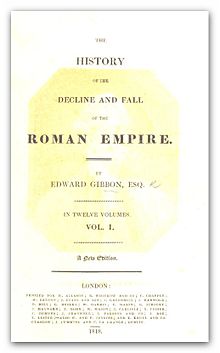The History of the Decline and Fall of the Roman Empire
The History of the Decline and Fall of the Roman Empire, "Istor diskar ha diwezh an Impalaeriezh roman", zo ul levr istor skrivet gant an istorour saoz Edward Gibbon (1737–1794) hag a gont istor ar sevenadurezh kornôgel – ennañ an aloubadegoù islamek ha Mongol – adalek an Impalaeriezh roman uhel betek diwezh Impalaeriezh Bizantion.
| Titl | The History of the Decline and Fall of the Roman Empire |
|---|---|
| Tachenn | non-fiction, Q50821840 |
| Embannadur | The History of the Decline and Fall of the Roman Empire, 1819 French translation, The History of the Decline and Fall of the Roman Empire, 1827 edition, The History of the Decline and Fall of the Roman Empire, 1897 edition |
| Aozer | Edward Gibbon |
| Lec'h embann | Londrez |
| Bro orin | Rouantelezh-Unanet, Bro-Saoz |
| Yezh an oberenn pe an anv | saozneg |
| Deiziad embann | 1776 |
| Pennlinenn | In the second century of the christian era, the empire of Rome comprehended the fairest part of the earth and the most civilized portion of mankind. The frontiers of that extensive monarchy were guarded by ancient renown and disciplined valour. The gentle, but powerful influence of laws and manners had gradually cemented the union of the provinces. Their peaceful inhabitants enjoyed and abused the advantages of wealth and luxury., Au second siècle de l’ère chrétienne, l’Empire romain comprenait les plus belles contrées de la terre et la portion la plus civilisée du genre humain. Une valeur disciplinée, une renommée antique, assuraient les frontières de cette immense monarchie. L’influence douce, mais puissante, des lois et des mœurs avait insensiblement cimenté l’union de toutes les provinces : leurs habitans jouissaient et abusaient, au sein de la paix, des avantages du luxe et des richesses., Nel secondo secolo dell’Era cristiana, l’Impero di Roma comprendeva la parte più bella della Terra, e la porzione più civile del genere umano. Il valore, la disciplina, e l’antica rinomanza difendevano le frontiere di quella vasta monarchia. La gentile, ma potente influenza delle leggi e dei costumi aveva a poco a poco assodata l’unione delle province, i cui pacifici abitatori godevano ed abusavano dei vantaggi che nascono dalle ricchezze e dal lusso. |
| Full work available at URL | https://standardebooks.org/ebooks/edward-gibbon/the-history-of-the-decline-and-fall-of-the-roman-empire |
| Statud ar gwirioù-oberour | domani foran, domani foran |

C'hwec'h levrenn a oa : al levrenn I e 1776, al levrennoù II ha III e 1781 hag al levrennoù diwezhañ e 1788–89.
An danvez
kemmañAr marevezh istorel etre 98 ha 1590 eo danvez an oberenn a gont an Impalaeriezh roman, istor deroù ar gristeniezh gant savidigezh an Iliz Stad roman. Kavet e vez ivez istor [[Europa]], ha klask a ra an istorour displegañ ar perag eus diskar an Impalaeriezh roman er c'hornôg hag er reter.
Dre ma klaskas sevel un oberenn istorel onest ha skiantel en ur implijout skridoù distank ar mare e voe adkemeret hentenn Edward Gibbon d'ober gant an istorourien a labouras war e lerc'h. Setu penaos e voe lesanvet Gibbon "ar c'hentañ istorour modern eus Henroma".
